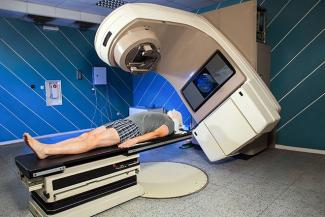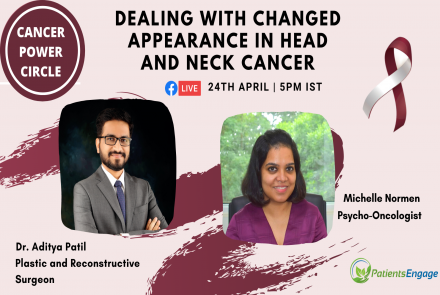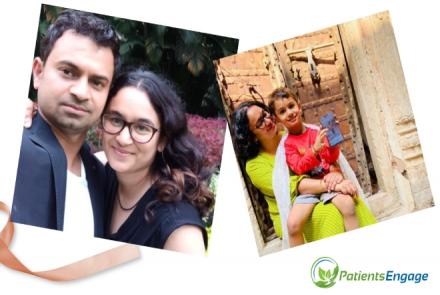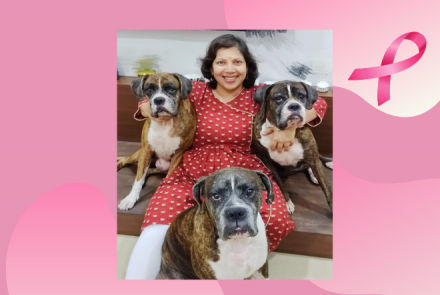
And other questions on types of radiation therapy and tips to handle the effects of radiation therapy answered by Dr. Arpana Shukla, Senior Consultant Radiation Oncology, Sterling Cancer Center Ahmedabad
1. What exactly is Radiation Therapy?
Radiation Therapy is a clinical modality mainly dealing with the use of ionizing radiations for the treatment of cancer patients (and occasionally benign diseases). The primary goal is to deliver a precisely measured dose of radiation to a clinically defined target volume and at the same time preserve the surrounding normal tissues so as to eradicate the tumor and prolonged the overall survival with good quality of life.
Broadly Radiation Therapy is of two types.
- External Radiation (external beam radiotherapy or EBRT) is a method for delivering a high-energy x-ray beam(s) to patients tumor from outside via specialized Radiotherapy machines.
- Brachytherapy also called internal radiation therapy refers to a treatment in which a high dose of radiation is given inside the body as close to the tumor as possible. In brachytherapy, the delivery device may be inserted into a body cavity such as the cervix or uterus (intracavitary brachytherapy) or applicators (usually needles or catheters) may be inserted into body tissues (interstitial brachytherapy). After appropriate planning on CT/MRI, a specified dose is delivered to the tumor by computer controlled source remaining in or near to tumor for a specified time. This is to deliver conformal very high doses with very sharp dose fall off which is impossible via linac based EBRT. It is commonly used for gynecological, prostate, head and neck, oesophagus, endobiliary, endobronchial, breast and soft tissue sarcoma. Brachytherapy requires an experienced team to plan and deliver these treatments in order to maximize control with minimal morbidity.
2. How does it affect the tumor?
Radiation therapy works by damaging the DNA within cancer cells and destroying their ability to reproduce that is mitotic cell death and involves distinct mechanism like apoptosis, necrosis, senescence and autophagy.
3. When is it generally used?
Almost two third of patients diagnosed with cancer require Radiation Therapy during course of their treatment .There are two possible goals of Radiation Therapy:-
- Curative Radiation Therapy with or without chemotherapy Can be used in Radical Setting for the purpose of curing the patient like oropharyngeal cancer, laryngeal cancer, Nasopharynx and Cervix cancer, and as an adjuvant (POST-OP) or Neo-adjuvant (PREOP) setting for breast cancer, gastrointestinal malignancy, soft tissue sarcoma etc.
- Palliative Radiation Therapy is designed to ameliorate a specific symptom such as pain (bone metastasis), obstruction (superior vena cava obstruction), bleeding and spinal cord compression, which is a medical emergency.
4. For which cancers is it not useful?
Management of cancer requires multidisciplinary approach and depends on the site, stage ,type of tumor and overall general condition of the patient. Some cancers are Radioresistant like Sarcoma, Melanoma, Adenoid cystic carcinoma but Radiation Therapy can be used in adjuvant and palliative setting. Radiotherapy is contraindicated in certain autoimmune disorders like SLE (lupus).
5. Is radiation painful?
Not at all! It is just high energy X rays delivered precisely to the tumor and patient will not feel any sensation during treatment. It also does not stay in body and it is safe to be with children and family after treatment.
6. How does radiation affect women and men of childbearing age?
While undergoing Radiotherapy to any site, adults of child bearing age are advised for contraception during and one year after completion of Radiotherapy. Ovaries and testes are very radiosensitive organs, when they are in or near to treatment field like in rectum cancer. Proper counseling is done with patient and relatives prior to Radiotherapy planning. Ovarian transpositions, sperm banking are options for such patients to preserve fertility.
7. What are the best ways to treat radiation burns and skin irritation?
Radiation dermatitis is the most feared side effect, but can be minimized with proper Radiotherapy planning and skin care. For example, we advise Head & Neck cancer patients to avoid shaving, applying any cream or rubbing the affected area. Patients are advised to keep the area dry and clean, use mild soap (like Dove) to wash, and wear loose cotton clothes.
How to Manage Side Effects of Radiation Therapy?
8. What are the risks and potential side effects of radiation therapy?
The biggest risk of radiation therapy involves potential damage to normal cells, in addition to the cancerous cells. Side effects depend on the site of radiation, dose- fractionation schedule, volume of radiation, technique of radiation and patient related factors like co -morbidities and nutritional status etc. Side effects can be minimized with advanced radiotherapy techniques such as:
- Swallowing sparing IMRT – For reduction of dysphagia and aspiration
- Deep Inspiration Breath Hold (DIBH) – for sparing heart and left anterior descending artery to prevent future cardiac complications particularly in left sided breast cancer.
- Scalp sparing IMRT – to prevent hair loss even in patients with brain tumor.
- Tumors in close proximity to critical structures like Brainstem, Optic Chiasma; spinal cord can be adequately treated with Modern Radiotherapy Machine with sub mm accuracy.
9. What lifestyle changes does one need to make to improve the outcome of the radiation treatment and protect the body during treatments?
Key points to improve treatment tolerance are
- plenty of liquids,
- small frequent meals under supervision of nutritionist,
- physiotherapy depending on site of treatment ,
- good hygiene ,
- physical activity and
- positive attitude.
How to Manage Side Effects of Radiation Therapy?
10. What are some of the recent advances in radiation therapy?
Lots of improvements occur over a year in Radiation Oncology with the basic aim to give tumoricidal dose to tumor and protect normal tissues. Modern Radiotherapy is all about improving quality of life, functionality and improving outcomes by techniques like IMRT/IGRT/SRT as explained below:
- 3D Conformal Radiotherapy
In 3D conformal radiotherapy, the radiation oncologist shapes and precisely delivers high-energy x-ray beams to the disease site while optimally protecting normal tissues. 3D conformal radiotherapy uses high-speed computers to extract the CT/MRI data, perform three-dimensional isodose calculations, and overlay the data for the radiation oncologist’s and medical physicist’s analysis.
- Intensity Modulated Radiation Therapy (IMRT)
(IMRT) revolutionizes the Radiation treatment changing paradigm shift from wide field radiation to conformal radiation and thus led to better sparing of critical organs. IMRT achieves unprecedented conformity of the radiation dose, by applying two complex concepts of inverse treatment planning and modulation of the radiation beam. IMRT at one end of spectrum has its positives but with this technological innovation comes at spiraling rise in equipment cost, trained manpower, increased man-hours and quality assurance which directly or indirectly has to be passed on the patient.
- IGRT
Image-Guided Radiation Therapy (IGRT)
For cancers of organs that move with respiration, IGRT—the latest innovation in imaging technology—produce a beam that precisely follows tumor motion and sculpts highly focused radiation around it to protect surrounding healthy tissue from collateral damage. In addition, physician can confirm patient and target positioning just before treatment is delivered. This leads to shrinking of radiated area and therefore fewer side effects and ability to return to normal faster than with traditional radiation therapy.
With IGRT “Adoptive treatment planning” has become possible. This is the ability to adapt today’s treatment to yesterday’s delivered dose pattern based on tumor response adaptation, as well as target and normal structures shifting adaptation.
- Rapid Arc
Rapid Arc radiotherapy technology is a new approach to image-guided, intensity -modulated radiation therapy (IG-IMRT) that delivers precise treatments in shorter times than conventional IMRT.
Rapid Arc is more comfortable for patients because they spend less time in their daily treatments (less than two minutes) and return to their daily routine. Rapid Arc rotates 360 degrees around the patient, enabling the very small beams with varying intensity to be aimed at the tumor from multiple angles. Unlike helical IMRT treatments or other forms of radiation therapy, with Rapid Arc the radiation treatment being delivered to the patient can be modulated continuously throughout treatment.
- Gated Radiotherapy
it is one of the advanced techniques, which increase the treatment accuracy of IMRT and Rapid Arc in abdominal and thoracic cancers where in the position of tumor site may vary depending upon the respiratory rhythm. This displacement could be up to 2-3 cm. Using RPM, the tumor can be treated more precisely without much damage to the surrounding tissues.so in short it synchronizes patient’s own respiratory rhythm so that radiation is delivered when tumor is in the treatment field and hence it minimizes the damage to the surrounding and other vital tissues.
- 4 D Computed Tomography Planning and Delivery
4-D CT can produce a movie loop according to patient’s breathing pattern. Since CTs are 3D, if we add time as a 4th dimension, we have a “4D CT” or a 3D movie loop showing the motion of your internal organs as the patient breathes. We can use this to help us track and treat more effectively.
By tracking breathing patterns, this system applies the radiation beam only when the tumor falls within the planned treatment field. Patient breathes naturally and remains comfortable throughout the entire procedure.
- HD MLC and 6D couch
the new HD120 MLC multiyear collimator enables clinicians to deliver extremely precise radio surgical treatments, including intensity-modulated radiosurgery (IMRS). A multiyear collimator is a device with many computer-controlled mechanical "leaves" or "slats" that continually shape the treatment beam as the radiation is delivered from different angles around the patient. HD MLC also offers improved dose delivery characteristics, including a steeper dose fall-off gradient, so that the amount of dose delivered decreases rapidly outside the targeted area, protecting healthy tissues more effectively than is possible with earlier beam shaping devices.
- Stereotactic Radiosurgery (SRS)
Despite its name, stereotactic radiosurgery is a non-surgical procedure that delivers precisely targeted radiation at much higher doses than traditional radiation therapy while sparing healthy tissue organs nearby.
SRS is most commonly used for tumors in the brain or spinal column. Stereotactic radiosurgery when fractionated, called stereotactic radiotherapy, is a highly precise form of radiation therapy initially used to treat tumors and other abnormalities of the brain. Now it is also being used to treat cancer in other parts of the body in a procedure called stereotactic body radiotherapy (SBRT). SBRT is most commonly used for targets in the lung, spine, liver, pancreas and kidney, and is typically delivered in 1-5 sessions
- Frameless Stereotactic Radiotherapy (FSRT)
it is a minimally invasive computer-aided procedure—used to treat patients with brain cancer—which delivers a highly concentrated dose of radiation with millimeter precision. The dose is delivered in multiple fractions (3-30 treatments).
11. Can radiation cause cancer?
Due to advances in technology, survival of cancer patients has improved; hence a second malignancy which is a serious long-term consequence of the treatment of primary malignancies with a latent period of 10 to 15 years is a cause of concern.
The risk of developing second cancer is a complex issue and mostly depends on four factors
- the patient age at time of radiation treatment,
- genetic risk factors,
- the organ and tissue site receiving radiation( breast and thyroid more susceptible), and
- the dose and volume of tissue being irradiated by a particular radiation technology.
Modern techniques particularly Proton therapy reduces the risk of second malignancy.
Despite this risk, radiotherapy is very often worth using because without it the risk of dying from the primary cancer is vastly greater than the risk of a secondary malignancy from therapy, and secondly, unlike systemic chemotherapy, the side effect profiles of radiation are more tolerable and localised.
12. Should I avoid any medications while undergoing radiation therapy?
No need to avoid any routine medications while undergoing radiotherapy but it is advisable to discuss with Radiation Oncologist what medications you are on.
Dr. Arpana Shukla, M D Radiotherapy is a Senior Consultant Radiation Oncology at the Sterling Cancer Center Ahmedabad

















